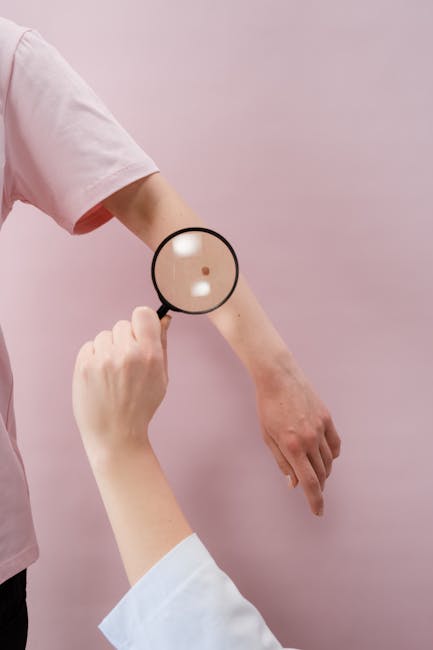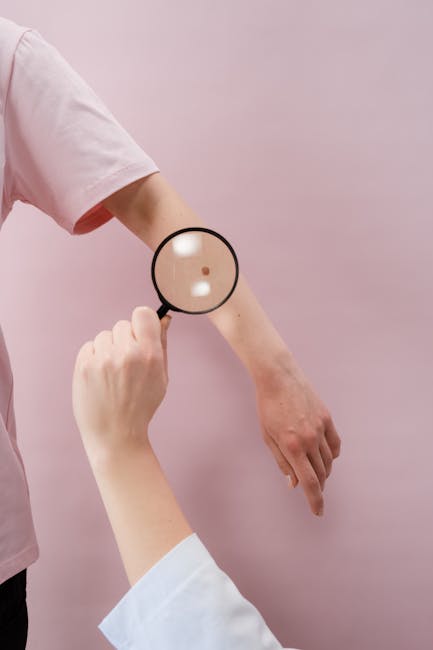Nevi (Moles): Understanding Types, Risks, and Prevention of Skin Cancer
Nevi, commonly known as moles, are small, pigmented spots on the skin. While most moles are harmless, some can be precursors to melanoma, the deadliest form of skin cancer. Understanding the different types of nevi, their characteristics, and the risk factors associated with them is crucial for early detection and prevention.
Types of Nevi
Moles are classified into various types based on their appearance, size, and the cells they originate from. The most common types include:

- Congenital Nevi: These moles are present at birth. They can be small or large (giant congenital nevi), and large congenital nevi carry a higher risk of melanoma.
- Acquired Nevi: These moles develop during a person’s lifetime, typically during childhood or adolescence. Most moles are acquired nevi.
- Dysplastic Nevi (Atypical Moles): These moles are larger and have irregular borders, uneven color, and sometimes a raised surface. They are considered to be at higher risk for developing into melanoma than common moles.
- Spitz Nevi: These are dome-shaped or papular moles that are usually pink, red, or reddish-brown. While mostly benign, they can sometimes be confused with melanoma.
- Blue Nevi: These moles appear blue or bluish-black due to the deeper location of melanin in the skin. They are generally benign but should be monitored for changes.
Risk Factors for Melanoma
Several factors increase the risk of developing melanoma, including:

- Fair skin: Individuals with fair skin, light eyes, and blonde or red hair are at higher risk.
- Sun exposure: Excessive sun exposure, especially during childhood and adolescence, is a major risk factor.
- Family history: Having a family history of melanoma significantly increases the risk.
- Many moles: Having a large number of moles, especially dysplastic nevi, increases the risk.
- Weakened immune system: Individuals with weakened immune systems are at greater risk.
- Previous melanoma: Having had melanoma before increases the risk of developing another one.
- Exposure to tanning beds: Using tanning beds significantly increases the risk of melanoma.
Identifying Potentially Dangerous Moles: The ABCDEs of Melanoma
The ABCDEs of melanoma are a helpful guide for recognizing potentially dangerous moles. It is crucial to consult a dermatologist if you notice any of these changes:
- A – Asymmetry: One half of the mole doesn’t match the other half.
- B – Border: The edges are irregular, ragged, notched, or blurred.
- C – Color: The color is uneven and may include different shades of brown, tan, black, red, white, or blue.
- D – Diameter: The mole is larger than 6 millimeters (about the size of a pencil eraser).
- E – Evolving: The mole is changing in size, shape, color, or elevation.
Prevention and Early Detection
Preventing melanoma is crucial. Here are some steps you can take:
- Limit sun exposure: Avoid prolonged sun exposure, especially during peak hours (10 a.m. to 4 p.m.).
- Use sunscreen: Apply a broad-spectrum sunscreen with an SPF of 30 or higher every day, even on cloudy days.
- Wear protective clothing: Wear long sleeves, long pants, a wide-brimmed hat, and sunglasses when exposed to the sun.
- Regular self-exams: Perform regular self-exams to check your skin for any changes in your moles or new spots.
- Professional skin exams: Schedule regular professional skin exams with a dermatologist, especially if you have risk factors for melanoma.
Treatment of Melanoma
The treatment for melanoma depends on several factors, including the stage, thickness, and location of the tumor. Treatment options may include:
- Surgical excision: The most common treatment, involving the surgical removal of the mole and surrounding tissue.
- Sentinel lymph node biopsy: A procedure to check if cancer has spread to nearby lymph nodes.
- Radiation therapy: Uses high-energy radiation to kill cancer cells.
- Chemotherapy: Uses drugs to kill cancer cells.
- Targeted therapy: Uses drugs that target specific molecules involved in cancer growth.
- Immunotherapy: Helps your immune system fight cancer cells.
When to See a Dermatologist
It’s crucial to see a dermatologist if you notice any changes in an existing mole or discover a new mole that exhibits any of the ABCDE characteristics. Early detection is key to successful treatment. Don’t hesitate to seek professional medical attention if you have any concerns about your moles.
Conclusion
Understanding nevi (moles) and the potential risks associated with them is crucial for maintaining good skin health. By practicing regular self-exams, protecting your skin from excessive sun exposure, and seeking professional medical attention when necessary, you can significantly reduce your risk of developing melanoma and ensure early detection if it does occur.


